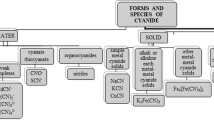Summary
An improved HPLC method was developed for determining the atmospheric concentration of toluene diisocyanate (TDI). 1-(2-pyridyl)-piperazine in toluene was used as reagent absorber solution together with reversed phase chromatography and a simple efficient buffer system (0.1 trifluoroacetic acid - acetonitrile, 85:15%) in an isocratic elution mode. The values for atmospheric TDI concentration obtained with two continuous band-tape monitors were checked using the values from HPLC as reference. Under identical experimental conditions the two instruments (both model 7005) gave readings varying by more than 100%. At low humidity the band-tape values were considerably lower than the HPLC values. At an absolute humidity of 11.7 gH2O/m3 (58% relative humidity) the value from instrument 1, but not instrument 2, agreed with those from HPLC. The values obtained with band-tape divices in the continuous monitoring of TDI concentration in places of work, or epidemiological studies, should be assessed with caution. HPLC offers a useful reference method for monitoring the accuracy of such devices.
Similar content being viewed by others
References
Baur X, Fruhmann G (1981) Specific IgE antibodies in patients with isocyanate asthma Chest 80:73S-76S
Baur X, Albrecht J, Huber RM, Kessel R, König G, Römmelt H, Fruhmann G (1982) Wirkung von Toluylen-Diisocyanat (0,02ppm) auf das unspezifisch hyperreagible Bronchialsystem. Verh dtsch Ges Arbeitsmed. Gentner Verlag, Stuttgart, pp 597–600
Baur X, Dewair M, Römmelt H (1984) Acute airway obstruction followed by hypersensitivity pneumonitis in an isocyanate (MDI) worker. J Occup Med 26:285–287
Dharmarajan V, Rando RJ (1980) Critical evaluation of continuous monitors for toluene diisocyanate. Am Ind Hyg Assoc 41:869–878
Dunlap KL, Sandridge RL, Keller J (1976) Determination of isocyanates in working atmospheres by high speed liquid chromatography. Anal Chem 48:497–499
Goldberg PA, Walker RF, Ellwood PA, Hardy HL (1981) Determination of trace atmospheric isocyanate concentrations by reversed-phase high-performance liquid chromatography using 1-(2-pyridyl)piperazine reagent. J Chromatogr 212:93–104
Hardy HL, Walker RF (1979) Novel reagent for the determination of atmospheric isocyanate monomer concentrations. Analyst 104:890–891
Henschler D (ed) (1976) Band 1, Analytische Methoden zur Prüfung gesundheitsschäd-licher Arbeitsstoffe. Verlag Chemie GmbH, Weinheim, Bd. 1, D4, pp 1–2
Keller J, Dunlap KL, Sandridge RL (1974) Determination of isocyanates in the working atmosphere by thin-layer chromatography. Anal Chem 46:1845–1846
Keller J, Sandridge RL (1979) Sampling of isocyanates in air. Anal Chem 51:1868–1870
Marcali K (1957) Microdetermination of toluene diisocyanates in atmosphere. Anal Chem 29:552–558
McMahon R (1985) Using microprocessor-based technology to enhance the measurement and documentation of TDI/MDI exposures. J Elastomers Plast 17:132–139
McMahon R (1985, February) Response of the 7100, 7005, and 7000 to toluene diisocyanate atmospheres with varying relative humidities. MDA Scientific, Inc., Elmdale, Glenview, Illinois
McMahon R, Peterson L (1985) Characterization of a new R (NCO2) chemcassette to toluene diisocyanate atmospheres. MDA Scientific, Inc., Barclay, Lincolnshire
Pilz W, Johann I (1969) Spezielle analytische Methoden für die Arbeitsmedizin und Industriehygiene. III. Bestimmung kleinster Mengen von Hexamethlylendiisocyanat (Desmodur H) in der Luft. Z Anal Chem 248:149–153
Rando RJ, Abdel-Kader HM, Hammad Y (1984) Isomeric compostion of airborne TDI in the polyurethane foam industry. Am Ind Hyg Assoc J 45:199–203
Römmelt H, Baur X, Waller A (1984) Problematik und Lösungsversuche für die quantitative Bestimmung von Isocyanaten an gefährdeten Arbeitsplätzen. Verh dtsch Ges Arbeitsmed. Gentner Verlag, Stuttgart, pp 373–376
Sangö C, Zimerson E (1980) A new reagent for determination of isocyanates in working atmospheres by HPLC using UV or fluorescence detection. J Liq Chromatogr 3:971–990
Warwick CJ, Bagon DA, Purnell CJ (1981) Application of electrochemical detection to the measurement of free monomeric aromatic and aliphatic isocyanates in air by high-performance liquid chromatography. Analyst 106:676–685
Author information
Authors and Affiliations
Rights and permissions
About this article
Cite this article
Mazur, G., Baur, X., Pfaller, A. et al. Determination of toluene diisocyanate in air by HPLC and band-tape monitors. Int. Arch Occup Environ Heath 58, 269–276 (1986). https://doi.org/10.1007/BF00377884
Received:
Accepted:
Issue Date:
DOI: https://doi.org/10.1007/BF00377884




